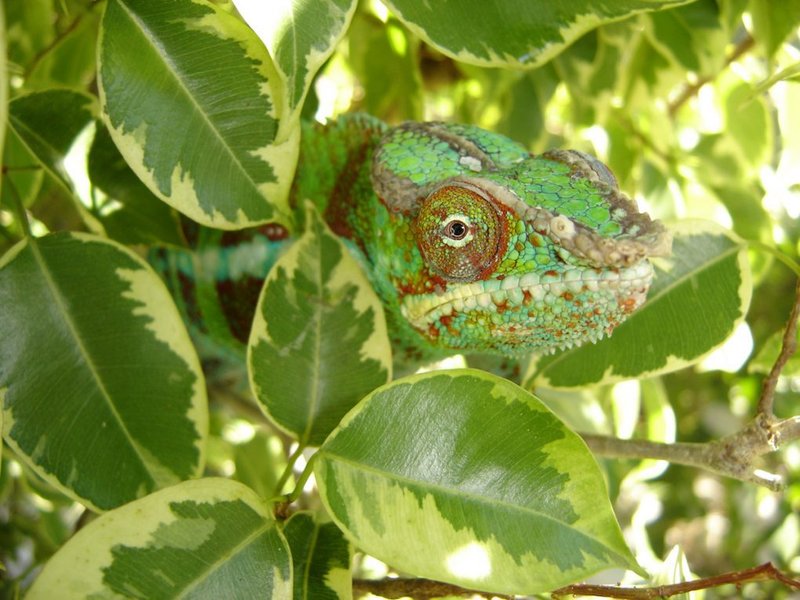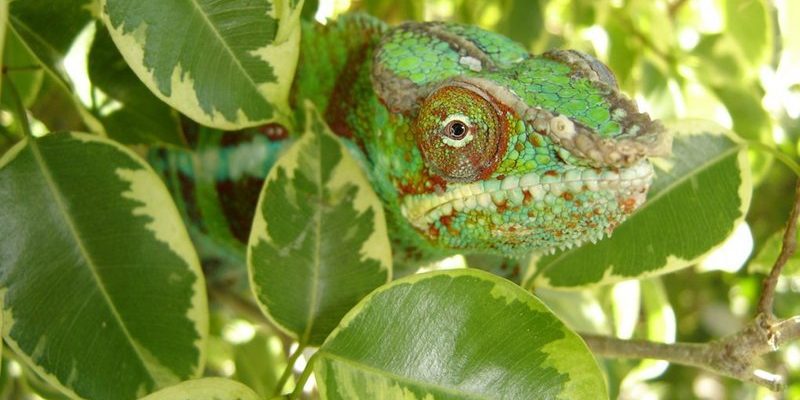
The veiled chameleon is unique, with its bright colors and fascinating behavior. But to keep your little reptilian buddy happy and healthy, it’s crucial to replicate their natural environment. This means choosing the right plants and décor that will provide both aesthetics and functionality. You may be wondering, “What do I need to include to make this habitat work?” Don’t worry; I’ll walk you through it, step by step.
Understanding the Veiled Chameleon’s Natural Habitat
Before diving into which plants and décor to use, it helps to understand where these chameleons come from. Veiled chameleons are native to Yemen’s mountainous regions, where they live in a warm, humid climate surrounded by lush greenery. This means their habitat should closely mimic these conditions with plenty of foliage and climbing opportunities.
For example, in the wild, they spend much of their time in trees, basking in the sunlight and hunting for insects. This natural behavior impacts how you should set up their enclosure. The ideal habitat mimics the vertical space they would have in nature. Here’s the thing: the more you can replicate their real environment, the healthier and happier your chameleon will be.
Choosing the Right Plants
When selecting plants for your veiled chameleon habitat, you want to pick ones that are not only safe but also beneficial. Here are some popular choices:
- Pothos: Known for its heart-shaped leaves, pothos is easy to care for, grows quickly, and offers plenty of climbing opportunities.
- Spider Plant: This is another hardy plant that thrives in various conditions and has arching leaves for your chameleon to explore.
- Ficus Benjamina (Weeping Fig): With its bushy foliage, this plant can provide shaded spots your chameleon may seek out.
- Live Oak or Schefflera: These can create a more natural feel while providing good hiding spots.
These plants not only filter the air but also help maintain humidity levels in the enclosure. Make sure to choose non-toxic varieties, as some plants can be harmful to your chameleon. If you’re unsure about a plant’s safety, a quick search can save you trouble later!
Creating Climbing Opportunities
You might be wondering how to make your habitat as functional as it is beautiful. One of the best ways is by incorporating various climbing structures. Veiled chameleons love to climb, so creating vertical space is essential.
You can use materials like:
- Branches: Natural branches, like driftwood, can be placed around the enclosure to encourage climbing.
- Vines: Adding vines can not only enhance the natural look but also provide additional climbing routes.
- Hammocks: These can create relaxing spots, allowing your chameleon to rest comfortably.
By adding these elements, you create a dynamic environment where your chameleon can exercise and explore. Remember, the more climbing options you provide, the happier your chameleon will be.
Incorporating Hides and Shelters
Just like us, chameleons need their own little hideouts to feel secure. Having places where they can retreat will help reduce stress. Adding shelters can also mimic the dark spots they would find in their natural environment.
Consider these options:
- Caves: Commercially available reptile caves are great for this, or you can create your own using natural materials.
- Plants with Dense Foliage: Some plants naturally provide shelter underneath their leaves, making them ideal for creating hideaways.
- Logs: Hollow logs can serve as an excellent shelter and also add to the aesthetic.
Placing these hiding spots strategically throughout the enclosure can help your chameleon feel safe and secure.
Lighting and Heat Sources
Lighting is crucial for your veiled chameleon’s health. They need a combination of UVB and heat to thrive. You might think, “How do I set this up?” Here’s a simple breakdown.
1. UVB Light: This helps your chameleon produce vitamin D3, which is vital for calcium absorption. Make sure you choose a full-spectrum UVB bulb and replace it every six months, even if it still lights up.
2. Basking Light: A heat lamp will create a warm basking spot where your chameleon can soak up heat. Place it at one end of the enclosure to create a temperature gradient.
3. Timers: Using timers for your lights can help simulate a natural day and night cycle, which is essential for your chameleon’s well-being. Aim for about 10-12 hours of light each day.
When you set up lighting and heat correctly, you help replicate the sunlit environment of their natural habitat.
Maintaining Humidity Levels
Humidity is another essential aspect of a veiled chameleon habitat. Since they come from humid areas, you’ll want to keep the humidity level between 50-70%. Here’s how you can achieve that:
– Misting Systems: Investing in an automatic misting system can ensure consistent humidity levels.
– Live Plants: As we mentioned earlier, live plants will naturally increase humidity because they release moisture into the air.
– Water Dish: Adding a shallow water dish can provide drinking water, but it’s essential to change it regularly to avoid bacteria build-up.
Regularly monitor humidity levels using a hygrometer to ensure that your environment remains ideal. Too much or too little humidity can lead to health issues for your chameleon.
Final Touches and Décor
Finally, let’s talk about the fun part: the décor! Adding personal touches can really make your chameleon’s habitat feel complete.
– Backgrounds: You can use a naturalistic background or a simple color to enhance the look of your enclosure. This can help reduce stress and make it feel like a more natural environment.
– Decorative Rocks: Adding some rocks can provide basking spots and add more visual interest.
– Natural Elements: Things like moss, leaf litter, or bark can enhance the look and feel of the habitat while also providing enrichment.
Remember, every item in the habitat should serve a purpose—whether it’s for climbing, hiding, or basking.
In conclusion, creating the best habitat for your veiled chameleon involves careful planning and thoughtful choices. By selecting the right plants and décor, you’re not just making a visually appealing setup—you’re providing a healthy environment that allows your chameleon to thrive. Your efforts will surely pay off when you see your chameleon exploring its beautiful home!

